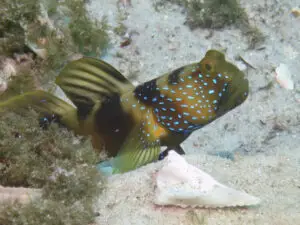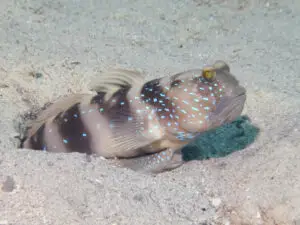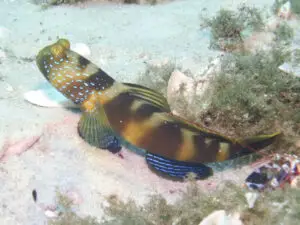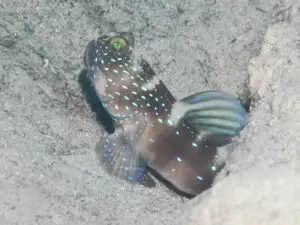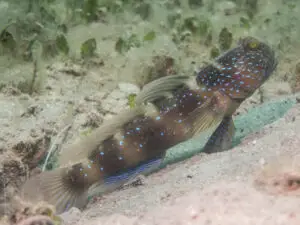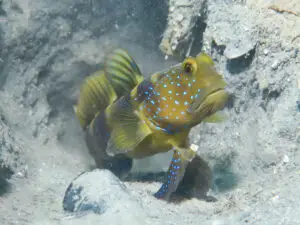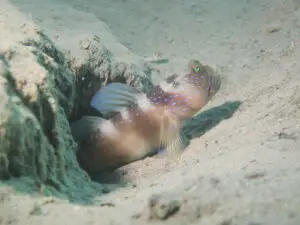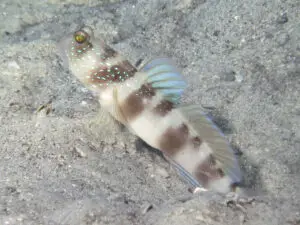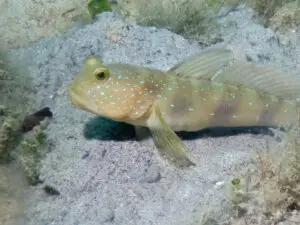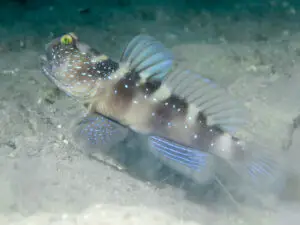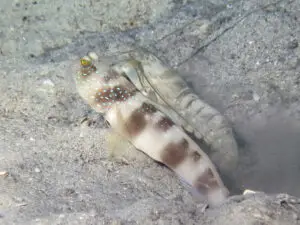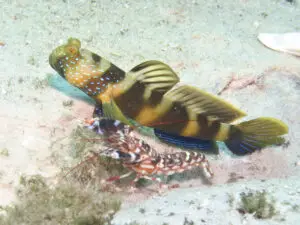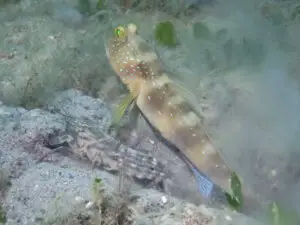Bluelined Shrimpgoby
Cryptocentrus bulbiceps
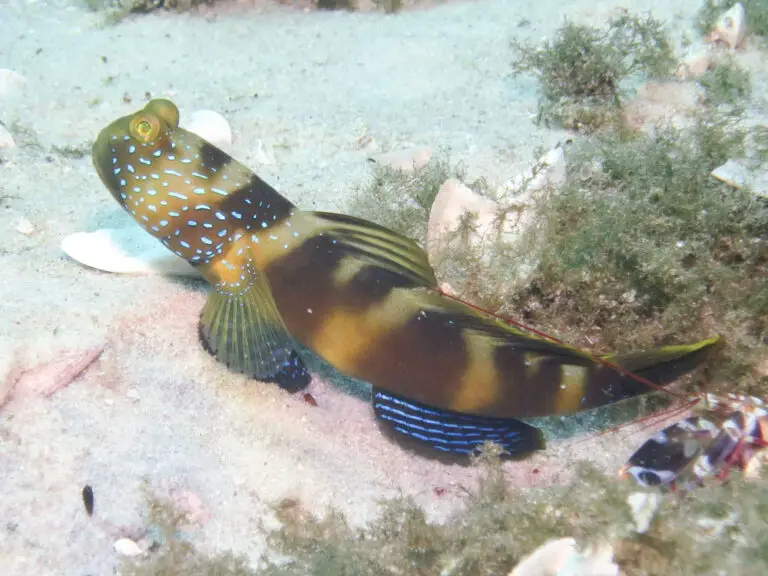
Bluelined Shrimpgoby
Cryptocentrus bulbiceps
(Whitley, 1953)
Description
A large, thick-bodied goby up to 15cm long.
Body design
There are two colour forms a grey and a yellow depending on the background colour of the body. On this, there are five prominent bars the first diagonal, the second and the fourth Y-shaped.
The obvious characteristic of this fish is its disproportionately large head and consequent tapering of the body. The pattern on the top of the head as far as the first dorsal fin is variable. In highly pigmented individuals the top of the head is pale but there is a dark bar across the nape of the neck not quite joining the first bar to make another Y-shape. In others, the whole head is dark with the only remnant of the pallor being a transverse pale line. Still others have very faint bars and the head is uniformly pigmented. These patterns are habitat-dependent.
Behind the eye there is a dark patch that may extend to the jaw. Covering this and extending as far back as the pelvic fin are lines of iridescent blue streaks. These continue along the body as two lines of less obvious blue spots.
Fin design
The first dorsal fin is rounded, uniformly translucent or reflective blue, depending on the illumination. The rays are outlined in dark brown.
The second dorsal fin rectangular, translucent with brown rays and a reflective blue border.
The pectoral fin matches the body colour with darker rays and iridescent blue spots covering the base.
The pelvic fin is dark with parallel arcs of dark outlined iridescent blue spots.
The anal fin is dark brown with four or five longitudinal lines in reflective blue.
The caudal fin is translucent with brown rays that are reflective blue in the lower half.
Diagnostic features
the large size and strongly contrasting dark bands make this a very recognisable fish of the silty sea bed.
Variation
In Hervey Bay we have found a very attractive form that is yellow with all the described features and strongly pigmented body bars making a striking contrast.
Similar species
Cryptocentrus fasciatus is smaller, inhabits sandy substrate, lives near the reef, associates with different shrimps and has a less tapered profile. There are differences in the fins, for example the parallel broken lines seen in the second dorsal fin in some C fasciatus have not been seen in C bulbiceps.
Cryptocentrus cyanotaenia also has iridescent blue streaks, rather than spots. These are restricted to the head and base of the pectoral fin, the same as Cryptocentrus bulbiceps. The anal fin, however, is yellow and grey, not black with parallel blue lines, and this distinguishes the two.
Nomenclature and taxonomy
It is by no means certain that this is a valid species, Our ichthyologist mentors tell us this is probably a variant of Cryptocentrus fasciatus but we have included it because the two seem, to our eyes, different in the field.
Cryptocentrus bulbiceps was described by Whitley in 1953. It is only known from the Holotype that was found at Palm Island, Queensland and a drawing and the type specimen.
Natural History
Habitat
The favoured conditions are areas of fine silty sand well away from fringing reefs and bommies. This large fish needs a substantial burrow and is associated with the Blue Nipper Shrimp and the Titan Shrimp, both large strong shrimps that make conspicuous burrows in the thick silty substrate. The Hervey Bay form was with a Tiger Shrimp, a smaller crustacean that prefers a sandy substrate, which was the case there. They were still well away from any reef and it is in the nature of Frazer Island that there are patches of silt with an admixture of sand.
Behaviour
At Frazer Island we have seen unusual behaviour in a large adult yellow individual. The fish in question was seen to move conspicuously over a wide area of algal mat and sand with no access to a burrow. It seemed to have become separated from its shrimp and burrow, possibly following an attack by a predatory fish. This impression was heightened by the fact that its tail was somewhat shredded.
Distribution
Published distribution: Red Sea and East Africa to Solomon Islands and Great Barrier Reef.
Our records:. We have found both the dark and yellow forms in Australia at Frazer Island, Blunt Bay, Percy Islands and Low Isles, Queensland.
Associated Shrimp species
Associated Shrimps (three shrimps)
Blue Nipper Snapping Shrimp, Alpheus cf digitalis
Tiger Snapping Shrimp, Alpheus bellulus
Titan Snapping Shrimp, Alpheus species 15

